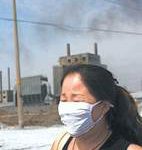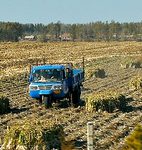The standard of living for China’s rural residents is clearly higher than it once was. The steamed buns we could not afford as children are now on every breakfast table. Many homes have electric fans, telephones, colour TVs, washing machines and even air-conditioning. Thatched roofs have been replaced with tiles. But the environmental price we have paid for these welcome changes is huge. The clean air and water that used to be the pride of the locals are now history. Rapid economic development has been achieved through the sacrifice of natural resources and the environment. Over the last three decades, China’s rural areas have seen the following environmental changes:
First, the countryside has been affected by pollution from fertiliser and agricultural chemicals and the emergence of plastic pollution (See “A sea of plastic”). Modern agriculture is over-reliant on the products of fossil fuels: fertilisers, pesticides, herbicides and plastic agricultural membrane. As a result, pollution has risen in tandem with harvests. China uses 434.3 kilograms of fertiliser per hectare of arable land on average, almost twice the safe limit. And only 40% of that is used effectively. Thirteen-and-a-half kilograms of herbicides and pesticides are used per hectare, 70% is highly toxic; 60% to 70% of this remains in the soil. Farms today are virtual killing fields, with orchards, vegetable gardens, farms the scene of “chemical warfare”. This misuse is worsened by efforts to grow out-of-season crops. Besides traditional crops like corn and wheat, farmers are planting peanuts, cotton, garlic, watermelons, tomatoes, cucumbers, tobacco and celery – all under plastic membrane. The agricultural sector needs 500,000 tonnes of membrane annually, 40% of which is abandoned. This becomes the plastic pollution that blights China’s countryside. Dung from livestock is a major cause of pollution; China produces twice as much livestock excrement as solid industrial waste; in some provinces four times as much.
Second, rural areas have seen the loss of wild animals and decreasing biodiversity.The use of large quantities of agricultural chemicals has not eliminated pests and weeds, but it has killed off large numbers of wild animals, especially predators that are needed to kill pests, and caused a severe drop in biodiversity. In the countryside in northern China you no longer see migrating geese in autumn or clouds of dragonflies in summer. There are fewer swallows due to a loss of nesting places. Varied forests have become poplar plantations. The disappearance of wetlands means frogs and other amphibians have lost their homes; river pollution has killed off fish and shrimp populations. Even snakes, which can end up on restaurant tables, are dying off after eating rats that have been killed by rat poison.
We haven’t just lost the dragonflies, cicadas, geese, swallows, magpies, titmice, frogs, snakes and hares; we have lost our natural environment. We once lived in a child’s natural paradise, full of animals and plants. But that is now just a memory. Will our children even know what dragonflies or cicadas are?
Third, the countryside has been blighted with homogenous tree planting and the removal of trees to the city (See “Trees are not enough”). For the sake of quick profits, rural residents are selling off their trees and planting quick-growing commercial replacements. In northern China, the traditional elm, pagoda tree, locust tree, ash, catalpa, paulownia, parasol tree, maple, willow, cypress and pine have all been replaced with poplars (See “China’s green deserts”). In the south, firs and masson pines are traditionally planted, but they are steadily being forced out by the eucalyptus, an Australian import. Tall old trees are sold to traders who resell them in large cities. Tree-lined avenues come at an environmental cost to rural areas. Entire villages now lack a single old tree, with new ones regularly cut down and sold, as if China were in a permanent state of growth.
Fourth, the Chinese countryside is losing its wetlands and its water.In the past, every child from a village could swim, but this is no longer the case. One agricultural university with a student body of 30,000 recently started a swimming club and found that only 30 people would sign up. The majority of students simply could not swim. A major cause is that ponds have been turned into dry land. With lakes, rivers and wetlands disappearing there is no water left in which to play. If there is any water in the rivers, it is polluted by factories upstream and nobody wants to get anywhere near it. The loss of wetlands has caused a fall in precipitation; many think this may be the cause of rainfall falling below historical averages by as much as 50%. This is particularly true in the arid north.
Fifth, straw burning is choking the countryside with fields of smoke (See “Waiting for the smoke to clear”). As no use has been found for straw, farmers simply burn it off after the harvests to save the trouble of proper disposal, causing major pollution problems, road closures and even forcing airports to close. Smoke exacerbated a light mist in Jinan on September 26, 2007, affecting 30 flights and forcing a flight carrying a Russian politician to make an emergency landing (damaging China’s national image in the process). Burning straw on neighbouring farmland also affects the cities, causing an increase in particulate matter. Ensuring blue skies in Beijing, for instance, is hampered by straw burning in the surrounding provinces.
Sixth, the countryside is losing its sand, soil and stone.Rapid urban and industrial development requires large quantities of building materials from rural areas. Sand is dredged and rivers have lost their capacity to absorb the impacts of flooding. Large areas of hillsides have been blasted for quarrying, the stone turned into building materials or “art” for sale in cities or overseas. This was once limited to a few unknown hills and mountains, but now even Mount Tai is at risk. Some believe that stone from the Taoist sacred site can guard against evil spirits and there is a brisk trade in ornamental rocks from the mountain. The bricks used in buildings are made from clay found in rural areas. Brick kilns are common in country villages. More worryingly, factories and urban buildings are not long-lasting and are often knocked down and rebuilt. The sand contained in the concrete is lost forever, sourcing new building materials causes yet more damage to rural environments.
Today, rural residents are better off than they once were, but the quality of their environment has declined. And with this has come an increase in illness. Is an increase in the standard of living worth the price of pollution and related health problems? Moreover, the rich rarely worry about the environment. Faced with this grim reality and an apathetic public, all we can do is cry for someone to save our environment.
Jiang Gaoming is a professor at the Chinese Academy of Sciences’ Institute of Botany. He is also vice secretary-general of the UNESCO China-MAB (Man and the Biosphere) Committee and a member of the UNESCO MAB Urban Group.
Homepage photo by rycordell



